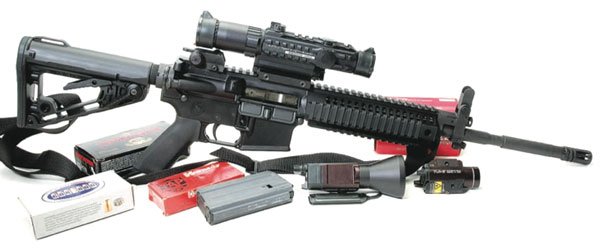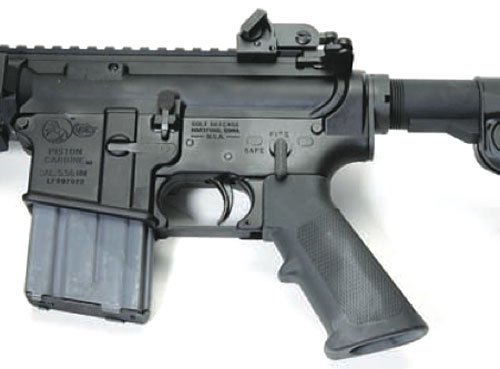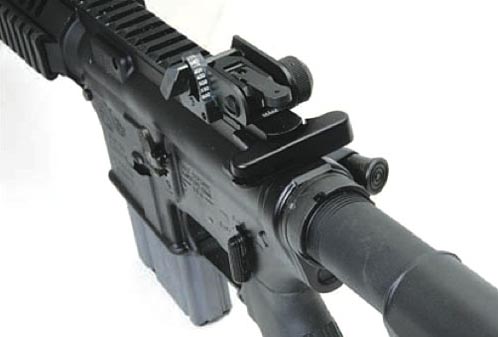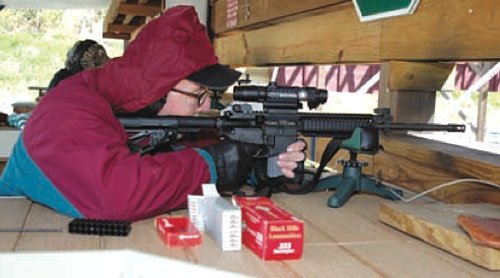
The Modern Sporting Rifle (MSR), as the AR-15 semiautomatic rifle is now identified, is the most popular rifle in the United States. In its original configuration as the M16 with semi- and full-auto capability, it is now the longest serving rifle in our armed forces. In military use, it has undergone, and continues to undergo, refinements as dictated by battlefield experiences.
The Colt LE6940 rifle (LE for Law Enforcement) has some of the most wanted modifications, including a choice of operating systems, as it can be had in either the original Direct Gas Impingement (DGI) system or Colt’s Piston Impingement System (PIS) which is a variation of a long established and well tested operating system in military rifles – the AK being the most proven of all. Choosing either system from Colt Firearms is a safe bet – with Colt being the only producer for decades of the DGI operated M16 in numerous configurations, along with the historic success of Colt’s piston system.
Colt LE6940P Features
Paraphrasing the Colt instruction manual, the Model LE6940P (“P” for piston) reviewed here is an Advanced Piston operated rifle. It features a monolithic upper receiver which has a MIL-STD-1913 (Picatinny) rail at the 12, 3 and 9 o’clock positions. The fourth rail, at six o’clock, is removable to give access for further cleaning of the rifle, if need be. The buttstock is collapsible to provide a better fit for various body sizes and the presence of bulky clothing. The rifle weighs 7.35 pounds (unloaded); the overall length is 35.5″ with the buttstock fully extended and 32.0″ when the buttstock is collapsed.

Space here prohibits a lengthy evaluation of the piston impingement system of operation used by the Colt LE6940P, where gas formed from discharging a cartridge moves a piston and a piston rod. The piston rod then impinges on the bolt to cycle the action. With the Colt articulating link system used here – a variant of the PIS – the gases vent off through a port near the barrel muzzle which allows the action to stay cleaner longer compared to the DGI system. (The DGI in the AR design directs the gas through a tube to operate the bolt. When doing this, the gas is carried into the rifle’s action, causing the action to foul earlier than it will with the PIS.)
Also, while some discussion is made of the relative accuracy of the DGI in an AR over the PIS, I see both systems being more than adequate for most purposes.
The LE6940P has a chrome lined, six groove barrel rifled 1 in 7″ twist, with a barrel length of 16.1″. The safety selector is reversible and particularly appreciated are the three supplied seven inch long composite snap on rail covers, as handling abruptly cornered rails with your bare hands can sometimes be unpleasant. Covers are cut to length as desired. The Rogers Super-Stoc allows changing the stock length to one of four positions and the stock can also be easily removed.
Sights on the Colt LE6940P
The LE6940P has adjustable Back-Up Iron Sights (BUIS) which are (according to the instruction manual) calibrated to make effective use of M855 ball ammunition. The front sight should be adjusted for elevation only for the initial zero. To lower the front sight, a large flat and grooved rectangular retaining latch is moved downward. To erect the sight, pull it up until it automatically locks. The MagPul windage and elevation adjustable aperture rear sight stalk is held up or down by a spring driven detent. Adjustments move the sight in half inch increments at 100 yards. The sight has white hash marks for windage changes and numbered white hash marks for elevation changes.

At the range, Joe Venezia and I were able to obtain very nice five shot groups using a 1-3x14mm Leopold Mark 4 CQ/T (Close Quarter/Tactical) sight with an aiming dot size of 3MOA (Minute Of Angle) at 3x and 9MOA at 1x power. We were shooting from a sturdy bench rest, firing best quality ammunition from Black Hills, Hornady, CORBON and Winchester.
Range Results
We did not expect great results with a low power optic and a measured, gritty 7.5 pound trigger pull which didn’t improve despite ample lubricating and repeated dry firing. As it turned out, those things were not an impediment, as Joe demonstrated with his first five shots. He shoots a lot of ARs in his gunsmithing work and it showed. After sighting in, Joe fired up the Black Hills and then followed with CORBON ammo. Before he looked through the spotting scope I was using, he apologized for his poor groups, pointing out that, with the scope’s magnification at 3X, the center aiming dot covers about three inches of the Shoot•N•C target at 100 yards.
What Joe was saying was that, when the scope is set at its highest magnification of 3X (which would allow for better placement of the dot on the 7.75″ diameter bull’s eye), the dot would also cover three inches of the target, making precisely replicating his sighting of each shot much more difficult. If he chose to power down to 1X to get a smaller dot, he would also decrease replicability. He chose 3X, but said he didn’t expect the best. As he fired, I scoped the targets and estimated he had the potential of shooting under two inch groups. My only comment to him was suggesting he just keep shooting and we’d hope for the best. (I didn’t want to jinx him.)
Measurements confirmed he shot well, as his first effort was a 1.5″ five shot group using Black Hills 73-grain Berger BTHP and his second target was a 1.75″ group using CORBON 69-grain BTHP. When I got behind the rifle, I could not match his work. I managed a 1.75″ four shot group, with one jerked shot for a final five shot spread of 2.00″ using Winchester 55-grain Ballistic Silvertip, followed by another two inch group using Hornady 75-grain TAP Precision BTHP ammo.

At this point, we agreed we were not going to get better results than what we had, so we stopped our formal accuracy efforts. Later, changing to assorted brands of 55-grain FMJ loads from Remington, Winchester, PMC and Federal and with the BUIS, I was able to shoot “minute of range” debris – sticks and dirt clods – with a good number of hits to go along with a few misses.
There were no problems with feeding from either of the two supplied Colt 20 round magazines. Extracting and ejecting were also trouble-free, with empty cases landing six feet to the shooter’s right rear side.
All of this shooting confirmed that the piston system gives more felt recoil compared to the direct gas impingement design but, while noticeable, it was not in the least bothersome physically when firing multiple shots. The lack of the gas system recoil buffer spring “twanging” in your ear with the DGI system was also nice. I particularly liked having the quickly detachable sling swivels and swivel holes at 9 and 12 o’clock. With the sling at 12 o’clock, the rifle is very comfortable moving around or for long-term carry. With the sling swivels at 9 o’clock, I could use a hasty sling which, if you have the time, is a definite aid for more accurate offhand shooting.
Final Thoughts
As to our results and what should be expected from this rifle, using a tactical optic and a gritty, heavy trigger is not the best way to go about finding out. But, they are what can be expected if you are looking at self-defense applications, not self-gratification from winning trophies. Based on past experiences, if we used the same ammo, a 6X to 24X target scope and we had polished up the trigger, I’m sure we’d have gotten into sub-one inch group territory at 100 yards!
As far as adding anything to the LE6940P, I would add a quality tactical light, such as one of the three new lights from Streamlight – the Streamlight TLR-1 HL, TLR-2 and TLR-1 HP models (this last one must be a relative of an aircraft landing light!), along with a good low power or no power optic. Other than this, the Colt Model LE6940P is just fine as is.
About the Author: Upon receiving his BS degree from Carnegie Tech and completing service as a Special Agent in U.S. Army Intelligence, Walt Rauch was a Special Agent with the U.S. Secret Service and an Investigator with the Warrant Unit, First Judicial District, PA. Rauch is also a writer and lecturer in the firearms field. He is published regularly in national and international publications.
501st says
I get 1 inch MOA on factory setup..
Aaron E says
Very nice and good to know. Though Colt has really had their noses in the air the last 20 years, I really do hope they succeed in turning things around and staying in the game.
501st says
Don’t like the trigger weight though. I use a Trijicon Accupower 2.5-10×56 on it and I love it. I think I just need to replace the trigger. I am also using self loaded 855 rounds though as well. I was surprised that this was the only Piston Colt made, or at least that I could find. I am not used to a piston that has such an odd, weak looking piston, but so far it performs flawlessly. I have an Adams Arms piston as well, the piston in that is not as silky as the colt, but it definitely seems tougher. With the Piston on the Colt, you really have to be careful not to fully disassemble it though as there is a sliding piece that is very tightly calibrated making it a ‘don’t clean if in a hurry” situation…not that it gets very dirty in the piston anyway. I just always wanted to buy a Colt since I used them when in Abn. Inf. back in the day.
Aaron E says
Great set up, and very interesting to hear about the performance and comparison of the piston as well. I have an Adams Arms piston upper and enjoy it very much.